
Poritia is a genus of lycaenid butterflies. The species of this genus are found in the Indomalayan realm. Poritia was erected by Frederic Moore in 1887.
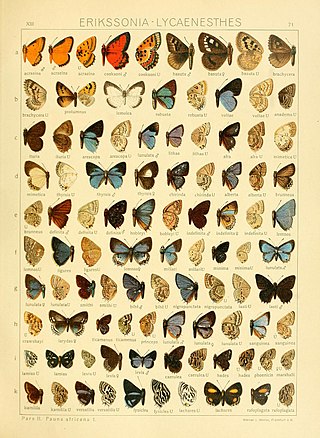
Anthene is a genus of butterflies in the family Lycaenidae, commonly called the ciliate blues or hairtails. The genus was erected by Edward Doubleday in 1847.

Poriskina is a monotypic butterfly genus in the family Lycaenidae. Its sole species, Poriskina phakos, is known from Mindanao in the Philippines. Both the genus and the species were first described by Hamilton Herbert Druce in 1895.

Tajuria is an Indomalayan genus of butterflies in the family Lycaenidae.

Tajuria mizunumai is a butterfly of the family Lycaenidae. It is found only on Mindanao in the Philippines. It was originally listed as a subspecies of Tajuria dominus, but was changed species status as Tajuria mizunumai by Colin G. Treadaway in 1995 and by H. Hayashiin 2017.
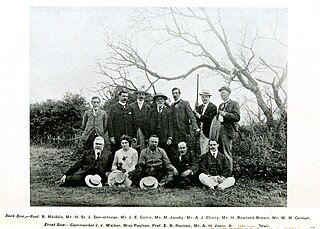
Hamilton Herbert Charles James Druce was an English entomologist who specialised in Lycaenidae and to a lesser extent Hesperiidae. He is not to be confused with his father, the English entomologist Herbert Druce (1846–1913) who also worked on Lepidoptera.
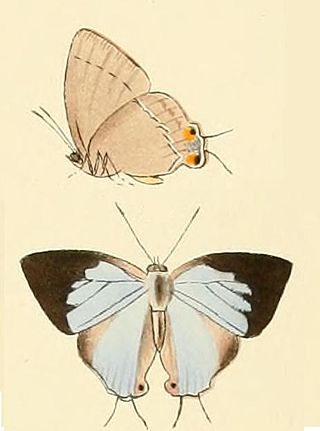
Tajuria ister, the uncertain royal, is a butterfly in the family Lycaenidae. It is found in Asia.
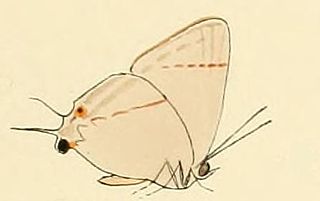
Tajuria diaeus, the straightline royal, is a butterfly in the family Lycaenidae. It is found in Asia.

Jamides zebra is a butterfly of the lycaenids or blues family first described by Hamilton Herbert Druce in 1895. It is found in South-east Asia.

Jamides virgulatus is a butterfly of the lycaenids or blues family. It is found on Borneo and Palawan.

Jamides limes is a butterfly of the lycaenids or blues family. It is found on Borneo.

Acytolepis ripte is a butterfly of the family Lycaenidae. It is found on Borneo.

Arhopala similis is a species of butterfly belonging to the lycaenid family described by Hamilton Herbert Druce in 1895. It is found in Southeast Asia . In this species, contrary to Arhopala catori, all the 4 spots in the costal area of the hindwing beneath are distinctly developed and in distinct light rings. In the forewing the postmedian transverse band is entirely absent, whilst in the hindwing it is broken up into hardly contiguous rings. Above the male is still more broadly margined with black than A. catori, particularly in the apex; the female is very similar to it, lighter blue.

Catapaecilma major, the common tinsel, is a species of butterfly belonging to the lycaenid family described by Hamilton Herbert Druce in 1895. It is found in the Indomalayan realm.
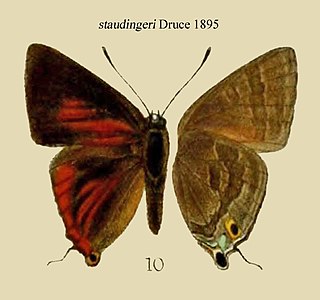
Deudorix staudingeri, the Large Cornelian, is a species of butterfly belonging to the lycaenid family described by Hamilton Herbert Druce in 1895. It is found in the Indomalayan realm, where it has been recorded from Nias, Sumatra, Borneo, Peninsular Malaysia and Singapore. The name honours Otto Staudinger.

Tajuria berenis is a butterfly in the family Lycaenidae. It was described by Hamilton Herbert Druce in 1896. It is found in the Indomalayan realm.
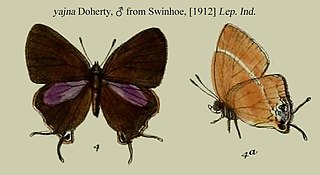
Tajuria yajna, the Purple royal, is a butterfly in the family Lycaenidae. It was described by William Doherty in 1886. It is found in the Indomalayan realm.
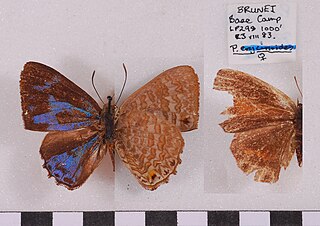
Poritia philota is a butterfly in the family Lycaenidae. It was described by William Chapman Hewitson in 1874. It is found in the Indomalayan realm.

Tajuria deudorix is a species of lycaenid or blue butterfly found in the Indomalayan realm
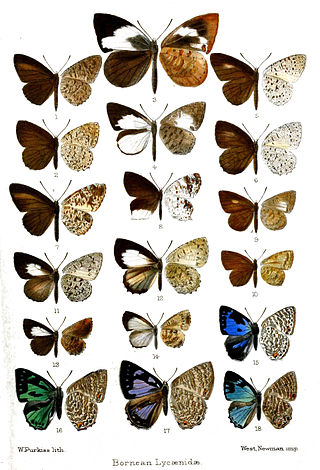
Poritia phormedon is an Indomalayan butterfly endemic to Borneo that belongs to the lycaenids, the blues family. Poritia phormedon was described by Hamilton Herbert Druce in 1895.




















